On February 17, Swedish brand Absolut Vodka, in cooperation with ICEHOTEL and Carrozzeria Japan (Chuo ward, Tokyo), opened the Absolut Icebar Tokyo near Gaien Nishi Dori (Nishi-Azabu 4-chome, Tel: 03-5464-2161). Everything in the icebar -- from the walls and bar counter down to the drinking glasses -- is made from ice, which is transported to Japan from the Torne River in northern Sweden. The ice is reportedly the purest in the world.

Absolut Icebar Tokyo is the first of its kind in Asia. Other branches of the bar are located in Stockholm, London, and Milan. Consistent in design with the European versions, the temperature inside the bar is -5 degrees Celsius (23 degrees Fahrenheit), and the entranceway is equipped with an airlock to keep the cold air inside. Specially designed thermal capes and gloves are provided to customers.
The bar serves up a variety of original, Absolut Vodka-based cocktails. The price for one drink, which includes the entrance fee and use of a thermal cape and gloves, is 3,500 yen. Refills are priced at 1,200 yen (cocktails) and 1,000 yen (soft drinks), and a fresh ice glass costs 800 yen. With 75 square meters (800 square feet) of floor space, there is enough room for only one seated table and up to 50 people. Hours are from 5 PM to 12 midnight.
The original Absolut Icebar was established at the ICEHOTEL, the world?s first hotel made from ice, located in Jukkasjarvi, northern Sweden.
[Source: Roppongi Keizai Shimbun]


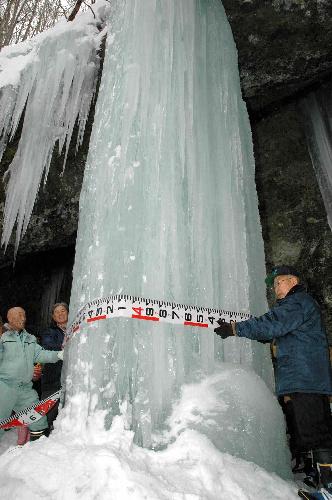 In a tradition that stretches back 700 years, local farmers in Hanamaki, Iwate prefecture measure the circumference of the frozen waterfall at Taroshi Falls to predict the yield of the year's rice crop.
In a tradition that stretches back 700 years, local farmers in Hanamaki, Iwate prefecture measure the circumference of the frozen waterfall at Taroshi Falls to predict the yield of the year's rice crop.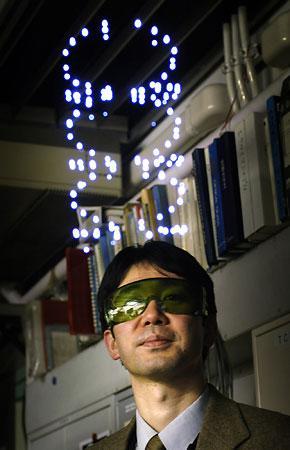 Japan's National Institute of Advanced Industrial Science and Technology (
Japan's National Institute of Advanced Industrial Science and Technology (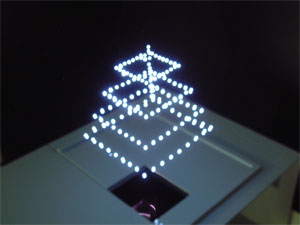 At the demonstration, bursts of laser light were emitted 100 times per second to form shapes in the air up to 50 cm above the device. Heat from the laser caused the air to expand, producing a crackling sound that resembled a series of tiny explosions.
At the demonstration, bursts of laser light were emitted 100 times per second to form shapes in the air up to 50 cm above the device. Heat from the laser caused the air to expand, producing a crackling sound that resembled a series of tiny explosions.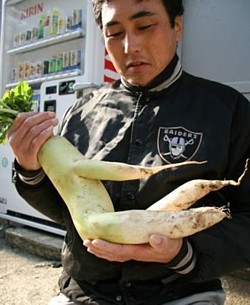 A daikon radish with a distinctly human shape is the talk of the town in Sasamicho, Wakayama prefecture.
A daikon radish with a distinctly human shape is the talk of the town in Sasamicho, Wakayama prefecture. A recycled hairstyling mannequin head has been called upon to keep crows away from a garbage collection point in Ube, Japan.
A recycled hairstyling mannequin head has been called upon to keep crows away from a garbage collection point in Ube, Japan.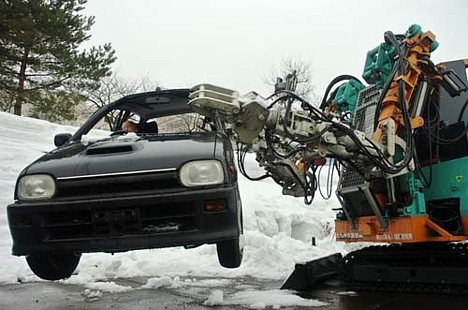

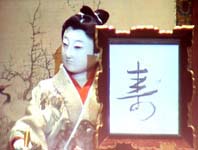 The "calligraphy writing doll" resembles a young man holding a brush in his right hand. With a series of movements fully controlled by precise automatic mechanisms, the young man dips his brush into ink and draws the kanji character for kotobuki ("blessing" or "longevity") on a sheet of paper in front of him. When finished, he seems to display a look of satisfaction to his onlookers.
The "calligraphy writing doll" resembles a young man holding a brush in his right hand. With a series of movements fully controlled by precise automatic mechanisms, the young man dips his brush into ink and draws the kanji character for kotobuki ("blessing" or "longevity") on a sheet of paper in front of him. When finished, he seems to display a look of satisfaction to his onlookers.